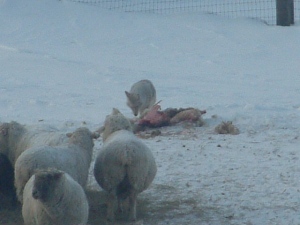The moon was nearly full and it was a breathlessly still fall night. My big, old, golden/labrador retriever, Bear, began barking and baying like one of her long-ago coon hound ancestors. When she stopped to take a breath, I heard the coyotes barking and howling in the field next to our yard. Our local coyote family was making its way past the farm on their weekly rounds.
 Coyotes fascinate me. Their howling and barking compel me to stop what I am doing to listen. I want the dog to hush so I can hear them. I wonder what they are saying to one another. “Gophers over here.” “I found a nest of mice.” I hope the message isn’t: “Sheep out of the fence. Supper!”
Coyotes fascinate me. Their howling and barking compel me to stop what I am doing to listen. I want the dog to hush so I can hear them. I wonder what they are saying to one another. “Gophers over here.” “I found a nest of mice.” I hope the message isn’t: “Sheep out of the fence. Supper!”
Many cultures around the world tell folk tales and legends with coyotes as characters. They are depicted as smart, conniving tricksters. Ancient people must have shared my fascination with the creatures. They must have watched them and listened to their conversations with wonder and mixed admiration, just as I do.
Coyotes are resourceful and adaptable. They will eat just about anything they can catch, including cats, dogs and sheep. They can survive on everything from berries and carrion to the garbage in suburban dumpsters.
They are smart and territorial. They have long-term relationships. They stay with their mates for years. If you see a coyote and shoot at it and miss, you probably won’t get a second shot in the same place tomorrow. They have sharp ears and I swear can hear me get out of bed on those still clear nights when I hear them howling around the pasture fence. Most of the year, they hunt alone. Like all canines, they have an acute sense of smell and stay away from another coyote’s territory. An old shepherd once told me that if my coyote neighbors hadn’t acquired a taste for lamb chops that I should not kill them or chase them away. If I did, he warned, they might be replaced by animals that had a taste for sheep.
Coyotes manage to survive where most other wild animals disappear. They have adapted and moved into many suburban neighborhoods. Dumpster diving is easier than chasing down wild prey and cities have no shortage of mice and rats. Unfortunately, coyotes do not mind dining on city dwellers’ pet cats or chihuahuas. They are less afraid of people where they live in such close contact and have even attacked small children and hikers. This lack of caution is made worse by people who intentionally feed the animals. I read a story of a coyote in a Chicago suburb having casually walked into a fast food restaurant. Who knows what he was going to order. I don’t think he got as far as the counter before he was escorted out.
A few years ago, the local coyote population was decimated by an outbreak of mange. Their numbers dropped and I rarely heard them barking. Our farm was nearly overrun with rabbits. Some nights I counted 40 or 50 of them dining on the alfalfa bales in the hay lot. They stripped the bark of most of my fruit trees. There were so many that our dogs gave up chasing them. The gopher population exploded. There were holes everywhere. The rodents ate all the grass on acres of pasture surrounding their mounds.
The mange epidemic seems to have passed. The coyotes I have observed seem healthy and have good coats of fur. The rabbits are under control. This spring we had several coyotes who decided the sheep pen was a good place to find easy prey as winter dragged on. They killed and ate three full-grown ewes. Lately, they have not bothered my sheep. Apparently mice and gophers are plentiful enough and the risk of getting shot at isn’t worth a meal of lamb…for now.
Yet when the night is still and I hear howling and barking just outside the shadows created by the yard light, I am pulled out of bed to listen. With mixed feelings, I yell and make noise to chase the tricksters away.
